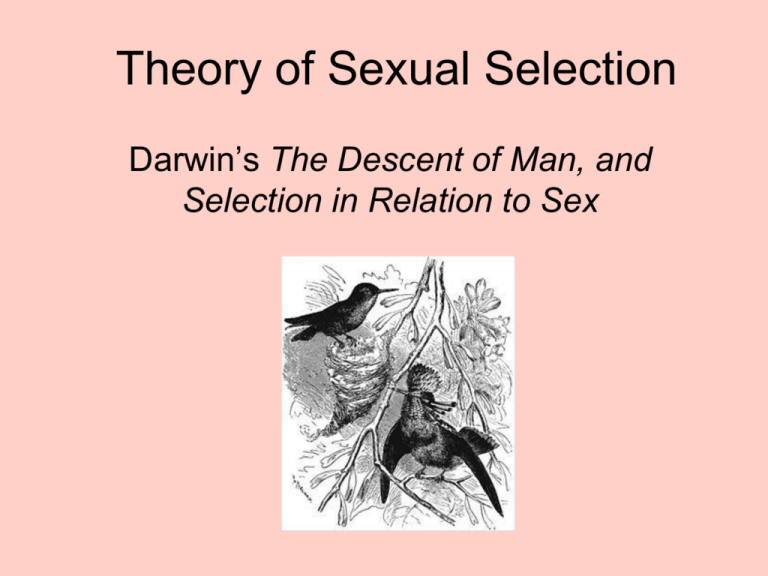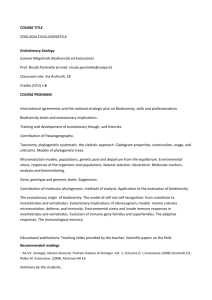
Theory of Sexual Selection
Darwin’s The Descent of Man, and
Selection in Relation to Sex
Sexual Selection
Darwin’s attempt to explain traits that defied
natural selection
Intersexual Selection
• “female-choice”
• Bateman’s Principle: the sex which
invests the most in producing offspring
becomes a limiting resource over which
the other sex will compete
Intersexual
Selection
Intrasexual Selection
• “Male-male competition”
• Strategies used to compete with
members of the same sex for access to
members of the opposite sex
• Female ornamentation produced at
expense of their offspring which makes
them lose fitness
Intrasexual
Selection
Sexual Dimorphism
• Differences between individuals of
different sex of the same species
• Male is larger in most mammals
• In insects, spiders, birds, reptiles,
amphibians the female is usually larger
Sexual Dimorphism
Sexual Selection and
Physical Attractiveness
Coloration in Animals
Female Mandrill: facial coloration
proportional with age (signals
reproductive ability)
Three Spined Stickleback:
Females prefer males with
intense red coloration
(signals parasite resistance,
because parasites reduce
intensity)
Physical Attractiveness- Skin
Coloration
Physical Attractiveness- Skin
• Skin color distribution influences perception of
female face
• Attractive signals correspond to high
Estrogen/Testosterone ratios
• Skin problems may signal a disturbance in E/T
ratio and reduced reproductive ability
Physical AttractivenessSymmetry
Physical Attractiveness- Symmetry
• Phenotypic indicator of biological fitness
• Fluctuating Assymetries (FAs) result from
genetic and environmental stresses during
development
• Indicates developmental homeostasis
• Cue of high parasite resistance (parasite theory)
– Defense against parasites: genetic diversity
(dependent on individual heterozygosity)
– Heterozygosity related to symmetry of bilateral traits
Physical Attractiveness- Scent
• Androstenone- secondary sex characteristic
(men give off three times more than
women)
• Secondary sex characteristics correlated
with offspring survival
• During ovulation, female is most fertile
• Increase in sensitivity to androstenone
Relativity in Physical Attractiveness
• Female choice is modified by female’s viability
• Female three-spined sticklebacks in worse
condition show preference for less brightly colored
males
• In humans, relative height
• Humans adjust preferences to increase pool of
partners
• Women who considered themselves physically
attractive showed greater preference for symmetry
in male faces
Summary
• Intrasexual and Intersexual Selection
• Sexual Dimorphism
• Physical Attractiveness
–
–
–
–
Coloration
Symmetry
Femininity
Scent
• Relativity
References
Bernhard, Fink, Grammer Karl, and Matts J. Paul. "Visible Skin Color Distribution Plays a Role in a Perception of
Age, Attractiveness, and Health in Female Faces." Evolution and Human Behavior 27 (2006): 433-42. ScienceDirect.
<http://www.sciencedirect.com/science?_ob=articleurl&_udi=b6t6h-4m04jfk
3&_user=961305&_coverdate=11%2f30%2f2006&_rdoc=1&_fmt=&_orig=search&_sort=d&view=c&_acct=c0000494
25&_version=1&_urlversion=0&_userid=961305&md5=b68ca079c97966e24723a5f170d31301>.
Derocher, Andrew, Andersen, Magnus, Wiig, Oystein. “Sexual Dimorphism of Polar
Bears.” Journal of Mammalogy 86 (2005): 895-901. Academic Search Premier. http://web.ebscohost.com.proxyum.researchport.umd.edu/ehost/detail?vid=4&hid=14&sid=839ea357-13a0-410f-ba8e6d1684f5723a%40sessionmgr8&bdata=JmxvZ2lucGFnZT1Mb2dpbi5hc3Amc2l0ZT1laG9zdC1saXZl#db=aph&AN=
18746448
Fisher, Maryanne L. "Female Intrasexual Competition Decreases Female Facial Attractiveness." Biological Sciences
271 (2005): 283-85. Jstor. <http://www.jstor.org.proxyum.researchport.umd.edu/stable/4142828?&search=yes&term=intrasexual&term=selection&list=hide&searchuri=%2
faction%2fdobasicsearch%3fquery%3dintrasexual%2bselection%26x%3d0%26y%3d0%26wc%3don&item=1&ttl=16
02&returnarticleservice=sh>.
Grammer, Karl and Thornhill Randy. "Human (Homo sapiens) Facial Attractiveness and Sexual Selection: The Role
of Symmetry and Averageness." Journal of Comparative Psychology 108 (1994). PsycARTICLES.
<http://web.ebscohost.com.proxy-um.researchport.umd.edu/ehost/detail?vid=2&hid=112&sid=67ef4cbc-abc4-42d8Kodric-Brown, Astrid and Brown, James. “Why the Fittest are the Prettiest.” Sciences 25 (1985): 26. EbscoHost
http://web.ebscohost.com.proxy-um.researchport.umd.edu/ehost/detail?vid=4&hid=6&sid=9cb7bd4e-5623-4c0fad788708c871ef80%40sessionmgr9&bdata=JmxvZ2lucGFnZT1Mb2dpbi5hc3Amc2l0ZT1laG9zdC1saXZl#db=aph&
AN=4862140
Lovich, J.E., Ernst, C.H., Zappalorti, R.T. & Herman, D.W. “Geographic variation in growth and sexual size
dimorphism.” American Midland Naturalist 139 (1998): 69. Academic Search Premier.
http://web.ebscohost.com.proxy-um.researchport.umd.edu/ehost/detail?vid=1&hid=16&sid=81322349-fced-4cc8a061186fe9e89bdf%40sessionmgr3&bdata=JmxvZ2lucGFnZT1Mb2dpbi5hc3Amc2l0ZT1laG9zdC1saXZl#db=aph&
AN=232450
References 2
Mesko, N. and Bereczkei, T. “Hairstyle as an adaptive means of displaying phenotypic quality.” Human Nature.
15 (2004): 251-270
http://researchport.umd.edu:80/V/5X73VS8XAY748XI92J51C4H25HLM7JSDXK17EK36D1I6TPSR8S05012?func=quick-3&short-format=002&set_number=034318&set_entry=000001&format=999
Neave, Nick, and Kerry Shields. "The Effects of Facial Hair Manipulation on Female
Perceptions of Attractiveness, Masculinity, and Dominance in Male Faces." Personality and Individual
Differences 45 (2008): 373-77. ScienceDirect. <http://www.sciencedirect.com.proxyum.researchport.umd.edu/science?_ob=articleurl&_udi=b6v9f-4sv0smc1&_user=961305&_coverdate=10%2f31%2f2008&_alid=818562343&_rdoc=1&_fmt=high&_orig=search&_cdi=5
897&_docanchor=&view=c&_ct=188&_acct=c000049425&_version=1&_>.
Ord, Terry J., Daniel T. Blumstein, and Christopher S. Evans. "Intrasexual Selection Predicts the Evolution of
Signal Complexity in Lizards." Biological Sciences 268 (2001): 737-44. Jstor. <http://www.jstor.org.proxyum.researchport.umd.edu/stable/3067621?&search=yes&term=intrasexual&term=selection&list=hide&searchuri=
%2faction%2fdobasicsearch%3fquery%3dintrasexual%2bselection%26gw%3djtx%26prq%3dthe%2bevolution%
2bof%2bsexual%2bdimorphism%2bb>.
Pawlowski, Boguslaw. "Variable Preferences for Sexual Dimorphism in Height as a Strategy for Increasing the
Pool of Potential Partners in Humans." Biological Sciences 270 (2003): 709-12. Jstor.
<http://www.jstor.org.proxyum.researchport.umd.edu/stable/3558774?&search=yes&term=dimorphism&term=sexual&list=hide&searchuri=
%2faction%2fdobasicsearch%3fquery%3dsexual%2bdimorphism%26wc%3don%26dc%3dall%2bdisciplines&ite
m=5&ttl=15437&returnarticleservice=>.
Penton-Voak, I.S., Little A.C., Jones B.C., Burt D.M., Tiddeman B.P., and Perrett D.I. "Female Condition
Influences Preferences for Sexual Dimorphism in Faces of Male Humans." Journal of Comparative Psychology
117 (2003): 264-71. PsycARTICLES. <http://web.ebscohost.com.proxyum.researchport.umd.edu/ehost/detail?vid=1&hid=12&sid=b95cff88-5909-486f-ac6d6d485d68762c%40srcsm1&bdata=jmxvz2lucgfnzt1mb2dpbi5hc3amc2l0zt1lag9zdc1saxzl#db=pdh&an=com117-3-264>.
References 3
Rodrigo, Cardenas A., and Harris J. Lauren. "Symmetrical Decorations Enhance the Attractiveness of Faces
and Abstract Designs." Evolution and Human Behavior 27 (2006): 1-18. ScienceDirect.
http://www.sciencedirect.com.proxy-um.researchport.umd.edu/science?_ob=ArticleURL&_udi=B6T6H4GPW3SV9&_user=961305&_coverDate=01%2F31%2F2006&_alid=818572202&_rdoc=2&_fmt=high&_orig=search&_c
di=5031&_sort=d&_docanchor=&view=c&_ct=3&_acct=C000049425&_version=1&_urlVersion=0&_userid=96
1305&md5=40a0b8369e0734034fca6d52a22e7ddf
Schulte-Hostedde, A.I. “Female Mate Choice is Influenced by Male Sport Participation.” Evolutionary Psychology. 6
(2008): 113-124. Jstor.
http://74.125.47.132/custom?q=cache:HPS5K8i32j0J:www.epjournal.net/filestore/EP06113124.pdf+Female+mate+choic
e+is+influenced+by+male+sport+participation+filetype:pdf&hl=en&ct=clnk&cd=1&gl=us&client=google-coop-np
Simmons, L.W. & Emlen, D.J. “No fecundity cost of female secondary sexual trait expression in the horned
beetle Ontophagus Sagittarius.” Journal of Evolutionary Biology 21 (2008): 1227-1235. Jstor.
http://www3.interscience.wiley.com.proxy-um.researchport.umd.edu/cgi-bin/fulltext/120736325/HTMLSTART
Thornhill, Randy and Gangestad, Steven W. “The Scent of Symmetry: A Human Sex Pheromone that Signals
Fitness?” Evolution and Human Behavior 20 (1999): 175-201 http://www.sciencedirect.com.proxyum.researchport.umd.edu/science?_ob=ArticleURL&_udi=B6T6H-3WWVBHG5&_user=961305&_coverDate=05%2F31%2F1999&_alid=830877376&_rdoc=1&_fmt=high&_orig=search&_c
di=5031&_sort=d&_docanchor=&view=c&_ct=2&_acct=C000049425&_version=1&_urlVersion=0&_userid=96
1305&md5=b3b9730b021870055bf628a4298525aa
Thornhill, Randy, and Grammer Karl. "The Body and Face of Woman One Ornament that
Signals Quality?" Evolution and Human Behavior 20 (1999): 105-20. ScienceDirect.
http://www.sciencedirect.com.proxy-um.researchport.umd.edu/science?_ob=ArticleURL&_udi=B6T6H3W9CYB53&_user=961305&_coverDate=03%2F31%2F1999&_alid=818393669&_rdoc=2&_fmt=high&_orig=search&_c
di=5031&_sort=d&_docanchor=&view=c&_ct=2&_acct=C000049425&_version=1&_urlVersion=0&_userid=96
1305&md5=8975239e65f3179d6a7ee33333290b64

